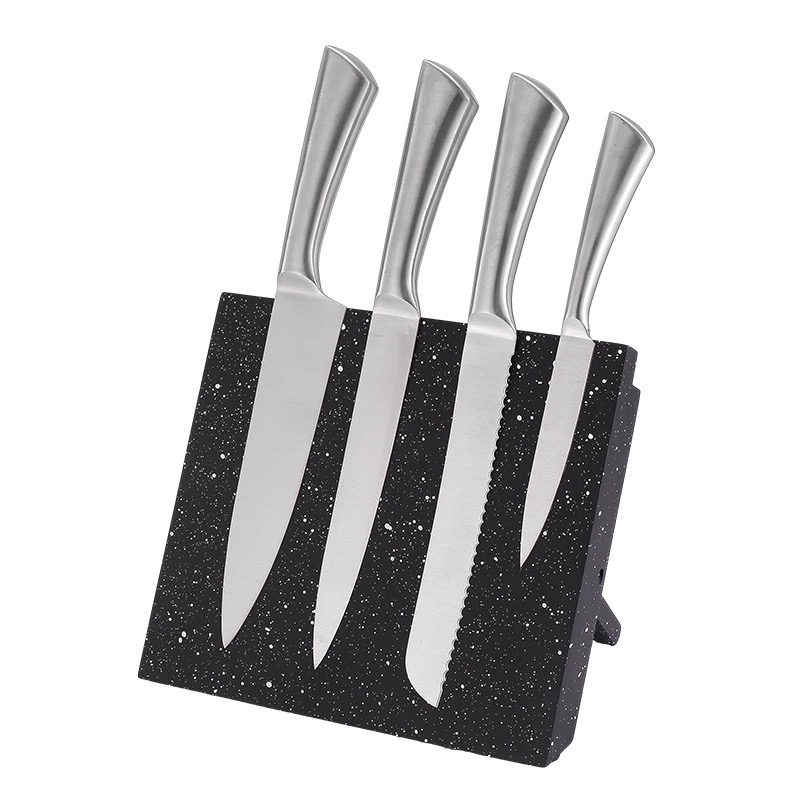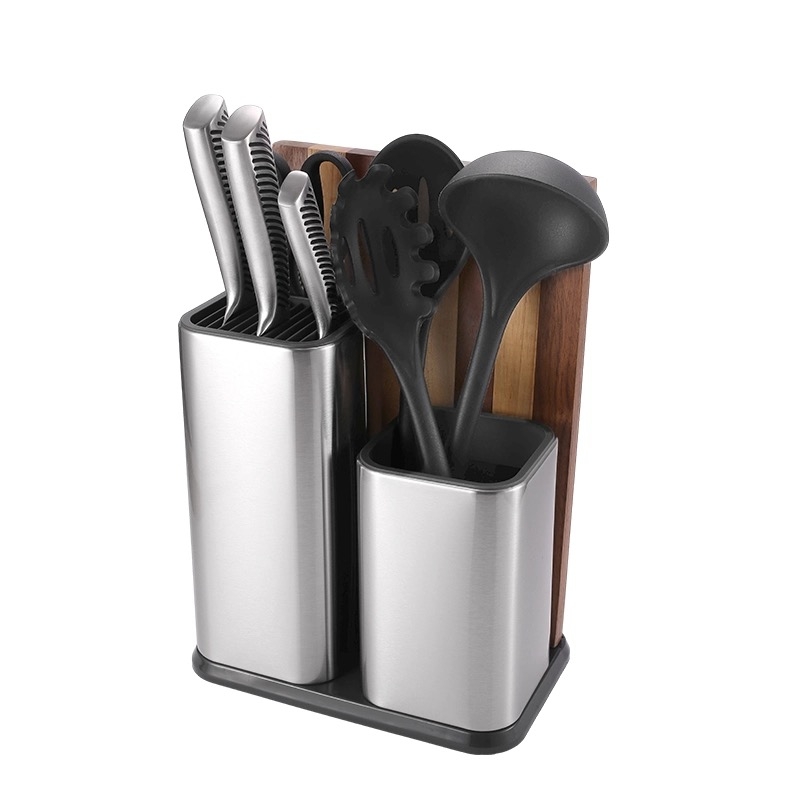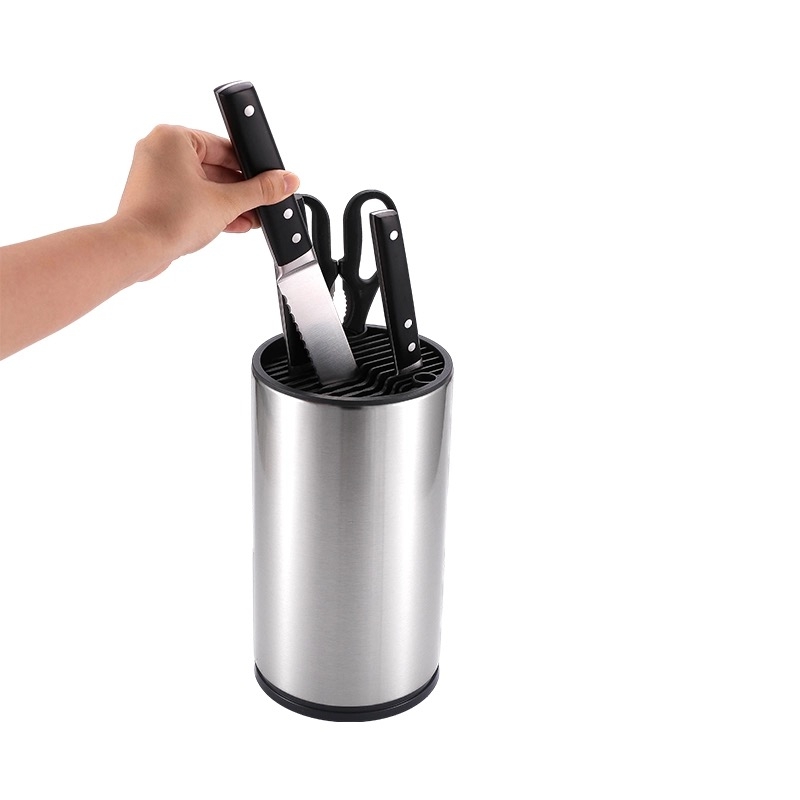Knives are essential tools in any kitchen, and their longevity is crucial for both culinary enthusiasts and professional chefs. One often overlooked aspect of knife maintenance is how they are stored. A knife holder, whether it be a block, magnetic strip, or drawer organizer, can significantly impact the lifespan and performance of your knives. This article explores the various types of knife holders, their benefits, and how they contribute to extending the life of your knives.
Understanding Knife Holders
What is a Knife Holder?
A knife holder is a storage solution designed to keep knives organized, protected, and easily accessible. There are several types of knife holders, each with its unique features and benefits. The most common types include:
Knife Blocks: Typically made of wood or plastic, these blocks have designated slots for each knife, allowing for safe storage. They often come in various designs, from traditional wooden blocks to modern acrylic options, catering to different kitchen aesthetics.
Magnetic Strips: These are mounted on walls and use magnets to hold knives securely in place, keeping them visible and accessible. Magnetic strips can be particularly useful in smaller kitchens where counter space is limited, as they utilize vertical space effectively.
Drawer Organizers: These are designed to fit inside kitchen drawers and often include protective inserts to prevent blade damage. Drawer organizers can be customized to fit various knife sizes and shapes, ensuring that each knife has its designated space.
Why Use a Knife Holder?
Using a knife holder is essential for several reasons. Firstly, it helps maintain the sharpness of the blades by preventing them from coming into contact with hard surfaces that can dull them. For instance, when knives are placed in a drawer without any protection, they can collide with other utensils or hard surfaces, leading to damage. Secondly, it protects the blades from damage, which can occur when knives are stored loosely in drawers or stacked together. Lastly, a knife holder promotes safety by keeping knives out of reach of children and reducing the risk of accidental cuts. This is particularly important in households with young children, where knife safety is a significant concern.

The Impact of Knife Holders on Knife Longevity
Protection from Damage
One of the primary benefits of using a knife holder is the protection it offers. Knives that are stored improperly can suffer from nicks, chips, and dulling of the blade. For instance, when knives are placed in a drawer without any protection, they can collide with other utensils or hard surfaces, leading to damage. Knife holders, especially those with soft inserts or slots, minimize this risk by keeping knives separated and secure. Additionally, some knife blocks are designed with materials that cushion the blades, further reducing the likelihood of damage. This protective feature is crucial for maintaining the integrity of high-quality knives, which can be a significant investment.
Maintaining Sharpness
The sharpness of a knife is crucial for its performance. A dull knife not only makes cooking more difficult but can also be dangerous, as it requires more force to cut through food, increasing the risk of slipping and injury. Knife holders help maintain sharpness by providing a safe environment where blades are not subjected to unnecessary friction or impact. For example, magnetic strips allow knives to hang freely without touching other surfaces, preserving their edges. Furthermore, some knife holders are designed to accommodate specific blade types, ensuring that each knife is stored in a manner that best protects its sharpness. This attention to detail can make a significant difference in the overall performance of your knives.
Reducing Wear and Tear
Over time, the way knives are stored can lead to wear and tear. For instance, placing knives blade-down in a wooden block can cause the edge to dull more quickly due to contact with the block's surface. Conversely, storing knives in a holder that allows for vertical storage can reduce this wear, as the blades are not in contact with any surfaces that could cause damage. Additionally, some knife holders feature angled slots that allow for optimal blade positioning, further minimizing wear. By investing in a quality knife holder, you can significantly extend the life of your knives and ensure they remain in peak condition for longer.
Types of Knife Holders and Their Benefits
Knife Blocks
Knife blocks are a popular choice for many kitchens. They offer several advantages:
Organization: Knife blocks keep knives organized and easily accessible, allowing for quick selection while cooking. This organization can enhance efficiency in the kitchen, as you can quickly grab the knife you need without rummaging through drawers.
Protection: The slots in knife blocks protect the blades from damage and help maintain their sharpness. Many blocks are designed with specific slot sizes to accommodate various knife types, ensuring a snug fit that prevents movement.
Aesthetic Appeal: Many knife blocks are designed to be visually appealing, adding a decorative element to kitchen countertops. A well-chosen knife block can complement your kitchen decor and serve as a focal point in your culinary space.
However, it is essential to ensure that the block is made of high-quality materials to avoid any potential damage to the blades. Some blocks are made from softer woods that can wear down over time, so selecting a durable option is crucial for long-term use.

Magnetic Strips
Magnetic strips are an innovative storage solution that has gained popularity in recent years. Their benefits include:
Space-Saving: Magnetic strips can be mounted on walls, freeing up counter space and keeping knives off surfaces. This is particularly beneficial in smaller kitchens where every inch of space counts.
Visibility: With knives displayed on a magnetic strip, it is easy to see and access the tools needed for cooking. This visibility can also encourage more frequent use of your knives, as they are always within reach.
Safety: By keeping knives out of drawers, magnetic strips reduce the risk of accidental cuts when reaching for utensils. Additionally, the open design of magnetic strips allows for better airflow around the blades, which can help prevent moisture buildup and rust.
Drawer Organizers
For those who prefer to keep their knives hidden, drawer organizers are an excellent option. They offer:
Discreet Storage: Drawer organizers keep knives out of sight, which can be beneficial in homes with children. This discreet storage solution can help maintain a tidy kitchen appearance while ensuring safety.
Protection: Many organizers come with protective inserts that prevent blades from coming into contact with each other or the drawer itself. This protection is essential for maintaining the sharpness and integrity of the blades.
Customization: Drawer organizers can often be adjusted to fit various knife sizes and shapes, providing a tailored storage solution. Some organizers even include compartments for other kitchen tools, allowing for a comprehensive storage solution that maximizes drawer space.
Best Practices for Using Knife Holders
Regular Maintenance
To ensure that your knife holder continues to protect your knives effectively, regular maintenance is essential. This includes cleaning the holder to prevent the buildup of bacteria and ensuring that the slots or magnetic surfaces are free from debris. For wooden blocks, it is advisable to oil them periodically to maintain their condition and prevent cracking. Regular maintenance not only extends the life of the knife holder itself but also ensures that your knives remain in optimal condition.
Proper Knife Placement
When placing knives in a holder, it is crucial to do so correctly. For knife blocks, ensure that the blades are inserted into the slots with the edge facing down to minimize contact with the block. For magnetic strips, place the knives flat against the strip to ensure a secure hold. In drawer organizers, arrange knives in a way that prevents them from touching each other. Proper placement not only protects the knives but also makes it easier to find and access them when needed.
Avoiding Overcrowding
Overcrowding a knife holder can lead to damage and difficulty in accessing knives. It is essential to choose a holder that accommodates your knife collection without cramming them together. If you find that your knife holder is too full, consider removing any knives that you do not use regularly or investing in a larger holder. Maintaining an organized and spacious knife holder can enhance your cooking experience and ensure that your knives remain in excellent condition.

Conclusion
In conclusion, a knife holder can significantly extend the life of your knives by providing protection, maintaining sharpness, and reducing wear and tear. Whether you choose a knife block, magnetic strip, or drawer organizer, the right storage solution can enhance your kitchen experience and ensure that your knives remain in optimal condition for years to come. By following best practices for knife storage and maintenance, you can enjoy the benefits of well-cared-for knives, making your culinary endeavors more enjoyable and efficient. Investing in a quality knife holder is not just about organization; it is a crucial step in preserving the functionality and longevity of your essential kitchen tools.
Frequently Asked Questions regarding Knife Holder
1. What type of knife holder is best for maintaining knife sharpness?
The best type of knife holder for maintaining knife sharpness is a magnetic strip. This is because it allows knives to hang freely without contact with other surfaces, reducing the risk of dulling the blades. Knife blocks with soft inserts can also be effective, as they cushion the blades and prevent damage.
2. How often should I clean my knife holder?
It is recommended to clean your knife holder regularly, ideally once a week. This helps prevent the buildup of bacteria and debris. For wooden knife blocks, use a damp cloth and mild soap, and ensure they are dried thoroughly to prevent moisture damage.
3. Can I store my knives in a drawer without a holder?
While it is possible to store knives in a drawer without a holder, it is not advisable. Loose storage can lead to blade damage, dulling, and increased risk of injury when reaching for other utensils. Using a drawer organizer or knife holder is a safer and more effective option.
4. Are there specific knife holders for different types of knives?
Yes, there are knife holders designed specifically for different types of knives. For example, some holders have slots tailored for chef's knives, paring knives, and serrated knives, ensuring that each knife is stored properly and securely. This helps maintain their shape and sharpness.
5. How can I tell if my knife holder is damaging my knives?
Signs that your knife holder may be damaging your knives include visible nicks or chips on the blades, dullness that occurs more quickly than expected, or difficulty in removing knives from the holder. If you notice these issues, consider switching to a different type of holder that offers better protection.






